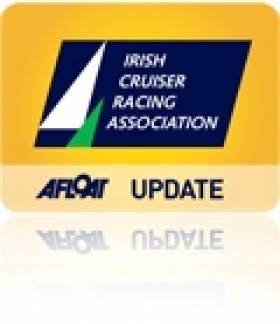Displaying items by tag: ISORA
#OFFSHORE – Storm damage means defending ISORA champion yacht Raging Bull, skippered by Matt Davis, from Skerries will not be on the start line off Dun Laoghaire tomorrow for the first ISORA race of the season.
According to locals the yacht broke its moorings when north easterly winds battered the east coast. The yacht was among others to be washed ashore in Skerries in north Dublin.
It is less than a week since the boats were craned in at Skerries Sailing Club. Below a photo of the conditions that led to yachts breaking moorings at the East coast port.

Riding the waves on moorings in Skerries Photo: Obscura Photography. For more shots of 'Stormy Skerries' on April 25th see the Obscura facebook page here.
The latest update on the situation comes from Des Fitz on Afloat's facebook page that 'skipper Matt Davis is hopeful to repair damage and try to compete in the end of the ISORA series'.
As the video above shows the 2010 and 2011 ISORA championship winning Sigma 400 was left on its side on the Skerries beach but it appears efforts to save the hull and rig were successful with the boat lifted by crane on to a truck and taken away for repair. Sad news for Matt and crew and all involved.
A video depicting the recovery of Raging Bull that was published on Vimeo is now a private view only
#OFFSHORE – 18 boats are expected on the line tomorrow morning for the start of the first ISORA offshore sailing race of the 2012 programme.
A split for Class 1 and Class 2 will be made but not until the morning and is subject to final entries.
15-20 knots of wind from the north east is expected and the above course is proposed.
The tide will be flooding for most of the race and as the fleet will most liklely avoid Wicklow Head in such circumstances the plan is to round North India instead of North Arklow buoy.
The course is 47 miles long, a route that should give two beats and loads of reaching and runs and return most boats to ISORA HQ at the National YC for results and a 'dry sherry' for 6pm.
Confirmation of the course will be given at the briefing on Saturday at 08.45 at Dun Laoghaire marina. It will also be broadcast on VHF Ch72 soon after. Boats are expected to return to Dun Laoghaire by 6pm.
#OFFSHORE – As the days get longer thoughts are turning to offshore sailing again and as Irish Sea Offshore Racing Association (ISORA) Commodore Peter Ryan writes 2012 promises to be a great year not just because it is Round Ireland year but because there are new and exciting things happening in ISORA.
We will be visiting Conwy and Keith Manders has already arranged a great social event on the Friday evening. We will be using the "virtual marks" that will ensure that there is a "corner" in every race. The schedule provides for feeder races to the ICRA Championships in Howth in May and Abersoch Keelboat Week in August. We will also be providing qualifying races for the Round Ireland.
I attach the Conditions, NoR and Entry Form for 2012. As we will be running a Silver Fleet it would be great to have some idea of likely entries as soon as possible. We are finalising Online Entry using PayPal for ISORA. We hope to have this complete next week. We hope this will make it handier to enter races.
I have now put all the ISORA trophies back into circulation and I hope that we can increase fleet numbers, populate the Sliver Fleet and ensure a better spread of trophies in 2012.
As I did last year, I will be coordinating a Crew Available list again this year. Anyone who does not have a place on a boat should complete the Excel sheet attached, indicating their availability for selected races. I am already aware of crew of all levels of experience who are looking for places on boats.
I hope as many of you as possible take part in ISORA in 2012 . Please do not hesitate to contact me if you have any queries on ISORA. I would also appreciate if you could promote ISORA within your Club – Peter Ryan
ISORA Race Programme 2012
28th April - ISORA / RAYC / Lee Overlay Day Race - (50 miles)
Dun Laoghaire to Nt. Arklow Cardinal
5th May - ISORA Offshore - Dun Laoghaire to Holyhead (60 miles)
Qulaifying Race
19th May - ISORA Offshore - Conwy to Howth (100 miles)
Qulaifying Race
2nd June - ISORA Offshore - Pwllheli to Wicklow (100 miles)
Qulaifying Race
14th July - ISORA Day Race – Pwllheli day race (35 miles)
27th July - ISORA / RAYC / Lee Overlay Night Race - (35 miles)
Dun Laoghaire to Nt. India Qulaifying Race
18th August - ISORA Offshore - (75 miles) Qulaifying Race
Dun Laoghaire – Pwllheli (T.B.C)
1st September - ISORA / RAYC / Lee Overlay Day Race - (54 miles)
Dun Laoghaire to M2
8th September - ISORA Day Race - Pwllheli day race ( 35 miles)
15th September - ISORA Offshore - Pwllheli to Dunlaoghaire. (80 Miles)
James Eadie Race – Qulaifying Race
Overall Series: To win the overall ISORA series for the Wolf's Head Trophy boats must complete 2 of the 6 "Qualifying". Points for the overall series will then be taken from the best 5 results. Prizes will be awarded for a separate series to include all races in the schedule.
N.B. - All races will have a weighting applied.
Howth Plans Big Event for 2012 ICRA Nationals
ICRA – the 2011 Club of the Year – laid out its stall until 2014 at the eighth annual conference in Dun Laoghaire at the weekend and the momentum is already building at Howth Yacht Club (HYC) who stage the 2012 National Championships at the beginning of next season.
The country's biggest yacht club has a potential sponsor in the wings and Saturday's conference also heard from the Club's Norbert Reilly that HYC is adding feeder events around the two day championships from May 25/27 to double the attraction of the North Dublin venue.
The Corby Cup will be sailed the weekend prior to the Nationals (19-20 May) and the Irish sea offshore body, ISORA, will stage a feeder race from Conwy in Wales to Howth. Both initiatives will encourage UK boats to travel to Dublin for the ICRA series.
Typically the ICRA event attracts over 100 boats in four different classes.
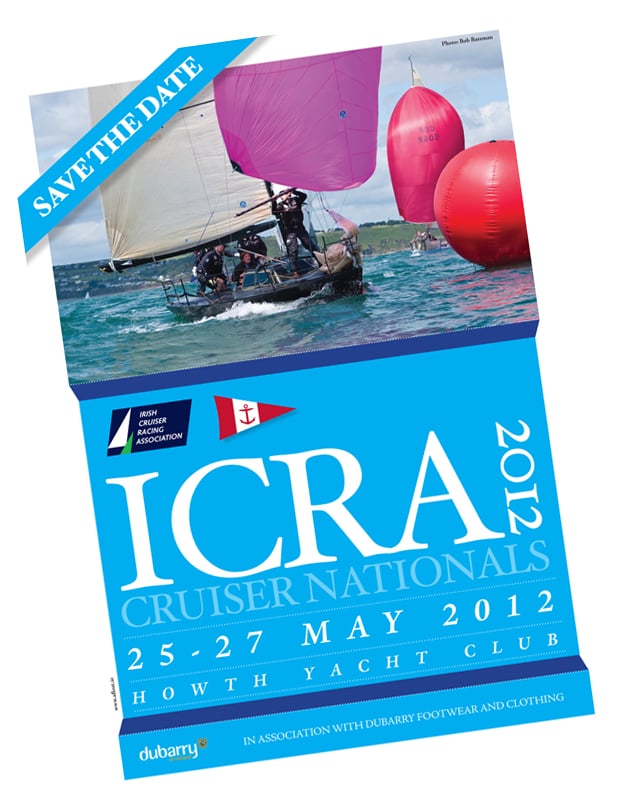
In spite of a dip in the size of the Cruiser fleet in Howth in recent years local boats are still taking some of the big prizes nationally with Reilly's Crazy Horse the 2011 Volvo Dun Laoghaire and DBSC Cruiser Challenge winner and Pat Kelly's J109 Storm picking up the weekend conference's top 'Boat of the Year' prize.
Ashore there are plans to make the event family oriented and a 'ladies lunch' is also planned.
The weekend's ICRA conference decided to do away with the crew limit rule for the seven race series in Howth as the association focuses on getting more crews out on the water to enjoy cruiser racing.
The ICRA Nationals goes West for a return visit to Tralee Bay Sailing Club in June 2013 and in 2014 the National Championships will be staged by the Royal Irish Yacht Club in Dun Laoghaire.
In the normal cycle of things 'the ICRAs' should be heading to the south coast again in 2015 but so far, the conference heard, the association is open to offers.
The 2012 ICRA Notice of Race for the Howth Championships will be available on Afloat.ie shortly
New Race From Conwy Features in 2012 ISORA Calendar
It was agreed that virtual marks would be in fixed positions on a trial basis. ISORA Commodore Peter Ryan believes it will 'revolutionise' offshore racing in the Irish Sea and produce better and more exciting racing.

The new ISORA waypoint positions
It was also agreed at the weekend's agm at the National Yacht Club in Dun Laoghaire that there would be two "Restricted / Silver Fleet" classes. The decision of what boats qualify for these classes will be made by the Sailing Committee prior to the first race. It is hoped that this will allow a fairer spread of prizes.
Virtual Waypoints Coordinates:ISORA A N52 45.000 W5 08.000
ISORA B N52 45.000 W5 40.000
ISORA C N53 06.000 W5 08.000
ISORA D N53 20.000 W5 08.000
ISORA E N53 20.000 W5 40.000
ISORA F N53 35.000 W5 08.000
ISORA G N53 35.000 W5 40.000
Preliminary Race Programme 2012
28th April - ISORA / RAYC / Lee Overlay Day Race - (50 miles)
Dun Laoghaire to Nt. Arklow Cardinal
5th May - ISORA Offshore - Dun Laoghaire to Holyhead (60 miles)
Qulaifying Race
19th May - ISORA Offshore - Conwy to Howth (100 miles)
Qulaifying Race
2nd June - ISORA Offshore - Pwllheli to Wicklow (100 miles)
Qulaifying Race
27th July - ISORA / RAYC / Lee Overlay Night Race - (35 miles)
Dun Laoghaire to Nt. India Qulaifying Race
18th August - ISORA Offshore - (75 miles) Qulaifying Race
Dun Laoghaire – Pwllheli (T.B.C)
1st September - ISORA / RAYC / Lee Overlay Day Race - (54 miles)
Dun Laoghaire to M2
8th September - ISORA Offshore - Pwllheli to Howth. (80 Miles)
James Eadie Race – Qulaifying Race
Overall Series: To win the overall ISORA series for the Wolf's Head Trophy boats must complete 2
of the 6 "Qualifying". Points for the overall series will then be taken from the best 5
results. Prizes will be awarded for a separate series to include all races in the
schedule.
All races will have a weighting applied.
There will be two Day Races starting and finishing in Pwllheli – dates TBC.
ISORA 2012 Looking at Trackers and 'Virtual' Marks
The moves come as the offshore body goes from strength to strength on the Irish Sea, recruiting more boats to venture out of Dublin Bay and to try longer distance races. It is a reversal of fortunes for offshore sailing that had been vitally wiped out just a few years ago.
The idea for the new marks sprung from last years' Lyver Race from Liverpool Yacht Club where a virtual mark was successfully used as a mark on the course (i.e. coordinates only).
The problem for ISORA though, with the exception of M2 buoy, is most of the marks used in ISORA raeces are within five to seven miles of the Irish coast and there are no marks off the Welsh coast.
Using virtual marks further off the coast would greatly help in setting courses that are not just long reaching legs. The day races, particularly from Dun Laoghaire could be far more interesting.
One of the problems about using the virtual marks though is the question of "how do you ensure that all boats have rounded the mark?"
The boats in the Lyver race had trackers fitted but ISORA commodore Peter Ryan says his experience of watching several boats round the 'mark' was that they tended to take it 'wide'.
Ryan is looking into the possibility of "obtaining" a set of trackers that could be used for all ISORA races.
Another suggestion is that a photograph could be taken on a mobile phone of the boat's GPS display at the time of the rounding. The photo would then be sent by SMS to the race office as part of the normal finish time declaration.
The feasibility of such a move is just one of the items on the agenda at the association's agm on November 19th at the National Yacht Club in Dun Laoghaire, a highlight of the offshore year.
Offshore Success - Raging Bull's Winning Story by Matt Davis
Matt Davis was at the helm of the Sigma 400 'Raging Bull' that successfully defended the ISORA Title in September. Here the Skerries Sailor describes how he and his crew parepared for the defence of the coveted Wolf's Head Trophy
To retain our title as ISORA champions I knew there was going to be a lot of work involved as some of the ISORA fleet would be upgrading their boats over the winter months. I held a crew meeting early in 2011 to discuss with the crew what steps we would take and how we would go about defending our title. The meeting proved useful and we even got new crew members! The 2011 ISORA Series was to include the Dun Laoghaire to Dingle race – with the new scoring and this race being rated the highest it was important to plan to do well in this race. The season started off eventful with the craning-in in Skerries - we broke one of the lower spreaders and this was one week before the first race. So within a week we had the spreader replaced and were on the start line for the first race in the ISORA calendar.
The first race was the Dun Laoghaire to Holyhead race, which was to take in the M2 buoy. The wind was east to south-east, there was a lumpy sea with light winds in Dublin Bay and at times it was difficult to keep the boat going. The crew kept a watchful eye on sail trim and we worked our way out of the bay into a more-steady breeze. The wind kept building and top out in the 30 plus knots true. For an opening race it was tough going but the Sigma 400 liked the conditions. We tacked about five miles north of the M2 buoy and held that tack all the way to the finish at Holyhead. We started the season with a win, but in the back of my mind I knew that the weather had a lot to play in our victory and it was only matter of time when Stephen Tudor would get his new J109 up to speed.
We missed the second race, to the North Arklow buoy due to a faulty starter motor. Pwllheli to Wicklow was the next race that we got to the starting line. Dave Jackson and some of the crew delivered to boat to Pwllheli. On the week leading up to the race I had been tracking the weather and Peter Ryan was promising his famous 'weather window'. On the morning of the race the wind was whistling through the rigging and I knew it was going to be tough going to Bardsley. We got a good start and were one of the first boats off the line. About 20mins into the race we noticed the fleet were all rounding a mark way inshore of us, we had to bare off and reach for the mark, we lost a good 10mins to the leading boats. As we reached the halfway point we had climbed back up the leaderboard. English Mick was charging out in front and Tsunami was in second place on the water followed by Aztec, Jedi and Sgrech. One by one we passed Sgrech, Jedi and Aztec but there was no catching English Mick or Tsunami. We finished 3rd on the water and later found out we won overall on corrected time. We were delighted as it was such a close race.
Dun Laoghaire to Dingle was the next race. There were a lot of points going for this race and we had to do well. For most of the race I knew I wouldn't know where the competition was so I had to be sure of my tactics. Dave Jackson had been looking at weather and tides while Paul Ruigrok was getting the boat through its safety check. The D2D was a cold tough race. We got second over all but won the ISORA division. This now put us in good contention to retain the series.
A good result in the Lyver race would see us cement our position on the ISORA series. It was a tough race with the wind very light not getting above 5 knots. It was too light for the Sigma to pull away from the J109 of Stephen Tudor. Stephen won the Lyver race and we had to settle for second.
The night race to North India was another light race, which saw us hugging the shoreline with depths recorded under the keel of less than a meter, to try and stay out of the stronger tides. Once again we were not successful in getting a good result; our decision to go inshore did not pay off and when we rounded the buoy we found ourselves way down the fleet trying to work our way back into the race. The next day race was around Rockabill, again another poor result, this time not the weather gods but the crew gods did not help us, as we were a few people short. It was a great race with Lively Lady winning and only 3 min between the first 5 boats!
So the last race of the season - Pwllheli to Howth, this race was shortened due to bad weather and the race was to finish in Dun Laoghaire. We got a great start and were lying in second place until about halfway when we blew out our headsail. We lost a lot of time and had to sail in the wrong direction to help get the sail down. We were now fourth on the water and chasing Tsunami, Sgrech and Jedi. We fought hard to finish second on the water and were very happy to finish 3rd on corrected time. We had successfully defended our ISORA title! To win the ISORA Wolfs Head Trophy once is great but to do it again is something very special and I am delighted to thank the hard working crew of Raging Bull for all there support: Dave Jackson, Ross McMahon, Tracey Carey, David Boyle, Paul Ruigrok, Clodagh Whelan, Ben Malone, Paddy Dillon, Derek Fitzpatrick, Gavin Laverty, Donal Ryan and Emma Wilson.
It's a credit to the crew that have fought hard to help me retain the title and to anyone out there looking to try their hand in ISORA next season all I can say is please join the fun and come sailing! It's very competitive with a real family feel to it. Barry Hurley is trying hard to get the two-handed division going so ISORA has something for everyone. I'd like to say a huge thank you to Peter Ryan for reviving ISORA and bring it back to its former glory.
Raging Bull Defends ISORA Title
The weather affected what is normally the most popular race of the series, the James Eadie race from Pwllheli to Howth. The severe weather forecast put many boats off travelling to Pwllheli. Some even turned back during the delivery to Pwllheli.
Only nine boats from an entry list of 25 came to the start line for the race. Due to the severe weather forecast it was decided that it would be prudent to shorten the race as much as possible and to change the course to go directly to Dun Laoghaire instead. This gave a course of 74 miles. In view of the overfalls off Bardsey Island, it was decided to remove Bardsey as a mark on the course.
The start was provided by Richard Tudor of the PSC. The wind at that time was southerly and was a steady 25knots. The first leg to St Tudwals was a tight fetch. The fleet encountered the first of the bad overfalls exiting through St. Tudwals sound. The next leg to Bardsey Sound was a tight reach. With the island blanketing the wind, conditions in the Sound were surprisingly tame. "Tsunami" was the first boat through the Sound and they cracked off to a beam reach to Dun Laoghaire.
The wind was building all the time during the race. The winds, on the reach to Dun Laoghaire, were a steady 30+ knots with gusts up to 40 knots. While the race was not a tactical challenge, steering the boat through the rogue waves kept the helms on their toes. With the exception of one boat who ventured a spinnaker, all the boats knuckled down and rode out the weather using white sails.
"Tsunami" led the fleet for most of the race taking line honours. They finished race in approximately eight and a half hours. The remainder of the fleet all finished within 75 minutes. "Tsunami" was pipped for first place by one minute by "Sgrech" and had to settle for 2nd Overall. "Raging Bull" took third place overall, 30 seconds behind "Tsunami". Class 3 was won by "Mojito" who also took 4th Place Overall.
"Raging Bull" and Matt Davis are the ISORA Overall Champions and the winners of the coveted Wolf's Head Trophy. They retained their ISORA Champion title for the second year in succession.
The finish was provided by Ronan Kieran of the NYC.
The prizes for the series will be presented at the ISORA Annual Prize Giving Dinner to be held in the NYC on the 19th November.
Offshore Sailors Consider 'Virtual Marks' for 2012 Fixtures
Taking a lead from this year's Lyver offshore sailing race, when Liverpool Yacht Club used a "virtual" waypoint as a mark on the course, ISORA may include this type of mark in future races, that's according to Commodore Peter Ryan. His comments come in a plea to members for feedback before the 2012 ISORA calendar is set at the ISORA agm on November 19th. Virtual marks would be a means to ensure that the offshore fleet get true upwind legs and still have reasonable length races.
It would, says Ryan of Dun Laoghaire's National Yacht Club, also facilitate the shortening of the day races. 'We have been around Rockabill so often over the last few years that the bird life there think we are residents!' he adds.
An exotic weekend in Dun Laoghaire with the start of an Olympic class keelboat event plus the arrival of a Volvo 70 into the harbour but Irish weather meant all did not go to plan. Click our links for a round up of the weekend's sailing events from around the country: Mansfield Wins 1720 Euros in Baltimore, Squall Puts Paid to First Race of Star Europeans in Dun Laoghaire, West Kirby Teams Top ISAF Worlds in Schull, Johnston's Beneteau 31.7 is Good Prospect, Killyleagh Pair Scoop Flying Fifteen East Coast Cup, Lively Lady Sails to Victory in Fickle ISORA Race to Rockabill, SB3 Team Sanya Welcome Scuppered by Strong Winds. We'll have more reports later this morning from the J24 Easterns in Howth, the National 18 season in Cork and J80 Match racing.



